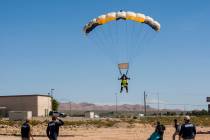Minor pests, major dangers – even in Las Vegas
They each weigh about 2.5 milligrams and fly about 1.5 mph. Smelly feet, women and blondes are particularly attractive to them, as is Limburger cheese.
You might think of them more as annoying pests than anything else.
I became so annoyed by their incessant biting during the Vietnam War that I fired a burst from my M-16 at them.
They are, however, far more than annoying - they're the most dangerous creatures on Earth.
Mosquitoes.
Yes, the type of insect that led to the death last week of a 75-year-old Las Vegas woman from the West Nile virus and has left two other Southern Nevadans fighting for their lives, kills as many as 3 million people each year around the world - by spreading diseases, often at dusk and dawn, that include malaria, yellow fever, dengue, encephalitis as well as the West Nile virus.
Mosquitoes also wound. In 2004, retired contractor Jonathan Friedrich was working around his Las Vegas home when he felt a bite. Four days later he was hospitalized. It took a year to recover from the West Nile-induced inflammation of his brain.
Without hesitation, scientists tell you that mosquitoes have been responsible for killing more people - largely through malaria - than all the wars in history. Their transmission of disease brings down toughened warriors as well as the weakened elderly and the fragile young.
In 1996, the Navy's Dr. Stephen Hoffman wrote: "In every military campaign this century, we lost more casualties to malaria than bullets. During World War II and the Vietnam War entire divisions ceased to be effective combat units due to malaria."
U.S. Army officials reported in 1996 that 8,000 military personnel in Vietnam were treated for a malaria that left them with uncontrollable shaking, fever and chills. I was lucky there. My immune system must have fought off the disease that sickened my buddies. I couldn't take anti-malaria medication because it turned my stomach upside down. Some Vietnam veterans still suffer from the effects of cerebral malaria, which can be mistaken for post-traumatic stress syndrome.
While Americans today know of malaria as something they can contract somewhere else - before traveling to many countries you must get a prescription for medication - in the 1930s millions of malaria cases were reported in the United States. Thanks to an intensive government effort that saw the creation of the Centers for Disease Control and Prevention, the draining of wetlands and the spraying of DDT, transmission of malaria was basically halted in the U.S. by 1950.
Today, the greatest threat from mosquitoes in the United States is developing encephalitis - an inflammation of the brain - from mosquitoes infected with the viruses of West Nile, St. Louis encephalitis, LaCrosse encephalitis, and Eastern equine and Western equine encephalitis.
Most deaths now come from West Nile induced-encephalitis - in 2012 there have been 163 in the U.S., compared with five from Eastern equine encephalitis and one from La Crosse encephalitis.
Lilian Cartright, whose home sits near Sahara Avenue and Valley View Boulevard, worries that her little girl will acquire West Nile. Mosquitoes were breeding at a nearby abandoned house's "green" swimming pool.
"They swarmed and bit her all over in our backyard," she said.
At Cartright's request, city code enforcement officers, who receive 468 such calls annually, went to the vacant home. They treated the shallow pool with killer chemicals.
Statistically, the six deaths from West Nile in Nevada and fewer than 100 confirmed cases in Clark County since the disease first hit here eight years ago wouldn't seem to give Cartright or anyone else much cause for concern.
After all, this is Nevada, where mosquitoes are few, where numbers of casualties from West Nile will never seem like much - unless, as Cartright points out, you or a loved one becomes one of the statistics.
With that in mind, remember there is no cure for the West Nile virus, only supportive care, so prevention is everything. Also remember this: A repellent with DEET is more effective than an M-16 at keeping the damn things off of you.
Paul Harasim is the medical reporter for the Las Vegas Review-Journal. His column appears Mondays. Harasim can be reached at pharasim@reviewjournal.com or 702-387-2908.

















